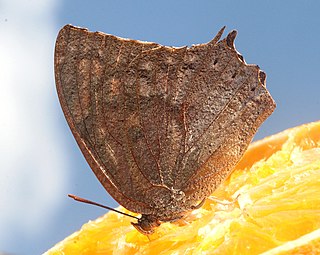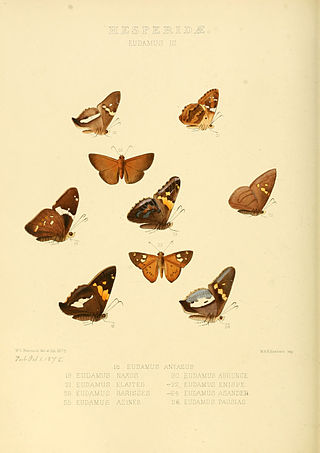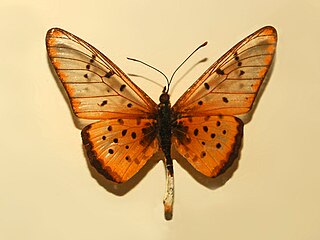
Skippers are a group of butterflies placed in the family Hesperiidae within the order Lepidoptera. They were previously placed in a separate superfamily, Hesperioidea; however, the most recent taxonomy places the family in the superfamily Papilionoidea, the butterflies. They are named for their quick, darting flight habits. Most have their antenna tips modified into narrow, hook-like projections. Moreover, skippers mostly have an absence of wing-coupling structure available in most moths. More than 3500 species of skippers are recognized, and they occur worldwide, but with the greatest diversity in the Neotropical regions of Central and South America.

The morpho butterflies comprise many species of Neotropical butterfly under the genus Morpho. This genus includes more than 29 accepted species and 147 accepted subspecies, found mostly in South America, Mexico, and Central America. Morpho wingspans range from 7.5 cm (3.0 in) for M. rhodopteron to 20 cm (7.9 in) for M. hecuba, the imposing sunset morpho. The name morpho, meaning "changed" or "modified", is also an epithet. Blue morphos are severely threatened by the deforestation of tropical forests and habitat fragmentation. Humans provide a direct threat to this genus because their beauty attracts artists and collectors from all over the globe who wish to capture and display them. Aside from humans, birds like the jacamar and flycatcher are the adult butterfly’s natural predators.

The Satyrini is one of the tribes of the subfamily Satyrinae. It includes about 2200 species and is therefore the largest tribe in the subfamily which comprises 2500 species.

Prepona is a genus of Neotropical charaxine butterflies in the family Nymphalidae. They are strong fliers in tropical forests where they feed on fermenting fruits and animal dung. The underside of the wings is pale greyish or brownish, while the upperside is dark with distinct iridescent blue markings. A few species also have orange markings on the upperside of the wings. They are popular among butterfly collectors.

The butterfly subtribe Euptychiina is a diverse group within the tribe Satyrini, occurring throughout Central and South America, in addition to a few species known from North America. Euptychiina is a predominantly lowland group, with the exception of one Asian taxon Palaeonympha opalinaButler, 1871 and the Andean genus ForsterinariaGray, 1973. The taxon was erected by Lee Denmar Miller.

Anaeini is a tribe of Neotropical brush-footed butterflies. Their wing undersides usually mimic dead leaves.

Cephise is a Neotropical genus of skipper butterflies of the subfamily Eudaminae, within which it is placed in subtribe Cephisina.

Phocides is a genus of butterflies in the skipper family, Hesperiidae, in which it is placed in tribe Phocidini, of which it is the namesake genus.

Telemiades is a genus of Neotropical butterflies in the family Hesperiidae.

Aguna is a genus of Neotropical skipper butterflies in the family Hesperiidae (Eudaminae).

Papilio androgeus, the Androgeus swallowtail, queen page, or queen swallowtail, is a Neotropical butterfly of the family Papilionidae. It is found from Mexico to Argentina with a small population in southern Florida.

Battus lycidas is a species of butterfly in the family Papilionidae native to the Neotropical realm. It is commonly known as Cramer's swallowtail, the Lycidas swallowtail, and the yellow-trailed swallowtail.

Acraea pseudegina is a butterfly of the family Nymphalidae, which is native to the African tropics and subtropics.

Anteos menippe, the great orange tip or orange-tipped angled-sulphur, is a neotropical butterfly of the family Pieridae.
Moneuptychia is a genus of satyrid butterflies found in the Neotropical realm.

Zaretis is a Neotropical nymphalid butterfly genus in the subfamily Charaxinae.

Parides tros is a species of butterfly in the family Papilionidae. It is found in the Neotropical realm where it is endemic to Brazil.

Eurytides asius is a species of butterfly in the family Papilionidae. It is found in the Neotropical realm in southeastern Brazil, and Paraguay.

Riodina lysippus is a species of Neotropical metalmark butterfly. It is the type species of its genus and of the entire family Riodinidae. It is found throughout northern parts of South America and the Caribbean.

Marpesia berania, the amber daggerwing, is a butterfly in the family Nymphalidae. The species was first described by William Chapman Hewitson in 1852. They are a brightly colored, Neotropical butterfly with a unique wing shape, found in Central and northern South America. The amber daggerwing exhibits several interesting characteristics varying from their unusual behavior to their physical traits that make them so distinct.




















